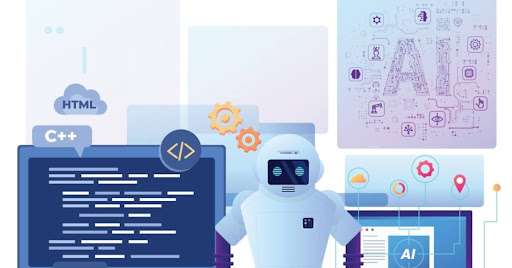The world of software development is shifting continuously, with new functionalities, features, and complexities rising at an increasing rate. Manual software testing is prone to human error and very time-consuming. Meanwhile, scripted automation cannot adapt to unpredictable changes.
To make software flawless, testing is a crucial aspect that ensures the overall quality of the software before it is launched in the market. However, testing requires a lot of resources and takes a long time.
What if there is a solution that makes software testing faster, more accurate, and more efficient? Yes, you read that phrase right!
Here, we are talking about AI (artificial intelligence).
In this fast-paced digitized era, artificial intelligence is not just two words; it has become a big game changer in software testing.
The future of software development is linked with artificial intelligence. AI-powered tools can learn user behavior, identify likely defects with high accuracy, and even discover potential software problems before they cause costly problems.
This is just a tiny glimpse of AI’s potential in software testing; there is more to it.
This blog post dives deeper into AI in software testing and its benefits. We will unlock the trends of this cutting-edge technology to know what the future unfolds.
But first, let’s start with some basics!
What is AI in Software Testing? What are Different AI Techniques Used in Software Testing?
AI in software testing is the application of artificial intelligence techniques to enhance, streamline, and automate the software testing process. It is similar to CRM software for small businesses, which automates repetitive tasks and frees up resources to focus more on strategic tasks.
AI utilizes basic scripting or machine learning algorithms and several other tools to carry out traditional tasks done by human testers.
Here is the breakdown of how AI works in software testing.
- Acquiring Data: AI tools collect data from several sources, such as code analysis, user behavior, and past test results.
- Learning and Analysis: Machine learning algorithms analyze this data to predict likely defects, identify patterns, and learn from past mistakes and successes.
- Action and Optimization: Based on the above analysis, AI tools generate test cases automatically based on likely problematic areas and learned user behavior. They run tests automatically and adapt to changes in the software UI (user interface) or functionalities.
AI tools analyze test results accurately, detect bugs, and suggest fixes. They create an optimized testing process by continuously learning and improving test strategies based on collected data.
Different AI Techniques Used in Software Testing
AI in software testing leverages a wide range of techniques, each offering unique strengths for diverse testing scenarios. Although AI uses various techniques in software testing, the following are the two prominent methods.
ML (Machine Learning)
Machine learning creates the backbone of several AI-powered testing tools. It includes algorithms that learn, adapt, and improve from experience by learning from large amounts of data. Machine learning offers three types of applications in testing: supervised learning, unsupervised learning, and reinforcement learning.
Supervised learning learns to identify patterns and classify new data points after you provide an algorithm with labeled data. This is particularly useful for analyzing code patterns and past bug reports to identify areas prone to mistakes. It evaluates existing test cases and prioritizes them based on their effectiveness in finding bugs.
Unsupervised learning includes algorithms finding patterns in unlabeled data. It identifies unexpected user behavior and flags unusual patterns in user data that lead to potential issues. On the other hand, reinforcement learning is a technique that involves an algorithm learning through experimentation (trial and error) and rewards for success. In software testing, reinforcement learning is used for adaptive test execution and autonomous test generation.
DL (Deep Learning)
Deep learning is an area of machine learning focused on a particular task. It utilizes complex artificial neural networks to process a massive amount of data. It recognizes complex relationships and patterns adeptly, which is ideal for analyzing screenshots and recordings to find visual defects in UI or user interactions. This feature is particularly advantageous for testing user interfaces or mobile apps with intricate layouts.
Benefits of AI in Software Testing
Incorporating AI in software testing unlocks huge advantages, which are:
Improved Efficiency and Speed
The software testing process involves many repetitive tasks, such as data validation and regression testing. AI adeptly automates these tasks, freeing up a lot of time for human testers. AI tools can quickly learn and replicate the steps involved in manual software testing. They automate test case execution and eliminate the need to perform this step repeatedly.
AI-powered scripts can adapt to minor modifications to UI, which ensures constant test execution without needing manual intervention. AI can simultaneously run multiple test cases on different cloud platforms or virtual machines, reducing the time spent on software testing compared to manual execution.
AI testing tools integrate seamlessly with CI (continuous integration) pipelines. This allows quick feedback loops, which enables developers to find and fix bugs rapidly in the software development cycle, accelerating the whole process.
Enhanced Reliability and Accuracy
Traditional software testing methods are prone to human errors and limitations. Here, AI tools offer consistency in the testing process, which significantly improves reliability and accuracy.
Human testers depend on their experience and judgment to identify defects in software. However, edge cases or small anomalies have a high potential to slip. With the help of machine learning and data anomaly detection, AI algorithms can find complex patterns that indicate likely defects and bugs that might go undetected by humans.
AI is adept at analyzing user behavior data and finding inconsistencies in expected patterns. AI is free from inattention, fatigue, and misinterpretation, ensuring the execution of consistent test cases every time.
Also, human testers subconsciously focus on different aspects during testing, which causes them to overlook other vital aspects. AI runs testing with an unbiased approach, which ensures all functionalities are evaluated thoroughly.
Proactive Testing and Deep Insights
Software testing is not limited to finding bugs. It is about understanding how software will behave and predict likely issues even before they occur. Here, AI analyzes code, user behavior data, and past bug reports to determine areas where software is prone to errors. This allows human testers to focus on high-risk areas to prevent likely issues that will occur later.
AI analyzes data from numerous sources and identifies patterns that predict software failure in the future. This way, developers can take preventive measures like additional testing or code refactoring before a significant problem occurs. AI analyzes risk factors and prioritizes test cases to ensure high-risk areas and critical functionalities get more in-depth testing.
Data gathered during software development provides valuable insights to developers. AI can extract hidden patterns from this data to gain deep insights into software behavior. It also identifies areas causing resource bottlenecks or slowdowns in software, allowing developers to optimize software for better performance.
Augmented Test Coverage
Attaining complete test coverage is still a big challenge for testers. Here, AI tackles this challenge and increases test coverage significantly. AI algorithms can analyze code structure, user behavior data, and existing test cases to generate new test cases automatically. These cases discover several edge cases and scenarios that go overlooked in manual testing.
It analyzes the effectiveness of existing use cases and finds areas for improvement. It suggests new combinations and variations of test steps to ensure an in-depth evaluation of certain functionalities.
AI can analyze real user interaction data and imitate their patterns in automated tests, which helps reveal potential issues that get overlooked during scripted tests. Also, AI-powered scripts adapt to minor modifications in UI that break into traditional scripts. This ensures the maintenance of test coverage as the software evolves.
AI analyzes associated risk factors in different functionalities and prioritizes cases accordingly. Critical areas with a high likelihood of defects get more thorough testing.
Continuous Learning and Improvement
Software testing is an ongoing process that requires continuous improvement throughout its cycle. Traditional testing methods can struggle to keep up with the ever-changing software landscape. AI leverages powerful machine learning algorithms to continuously learn, adapt, and improve the software testing process over time.
After each test run, AI analyzes and finds bug patterns in the failed and successful tests and identifies areas where existing tests are insufficient. This way, existing tests can be refined and new ones generated automatically that address newly discovered vulnerabilities.
AI utilizes a variety of data sources to automatically optimize the testing process. AI-powered tools seamlessly integrate with user feedback mechanisms such as app reviews and bug reports. This helps them analyze user pain points and find areas that need extra testing focus.
AI analyzes code patterns and historical data to predict likely issues before they become bugs. This enables developers to address issues proactively during the software development phase, minimizing the encounter of bugs in each test.
AI in Software Testing: Trends Shaping the Future
AI in software testing is evolving constantly with emerging trends and new advancements. The following are the key trends to watch in the future.
AI For Security Testing and Performance
AI potential goes beyond functional testing. Here is a glimpse of security testing and performance in the future.
- AI will analyze performance data to predict and analyze performance issues and potential bottlenecks before they start impacting real users.
- It will analyze code, network traffic, and user behavior to find likely security vulnerabilities and other suspicious activities.
Adoption of XAI (Explainable AI)
AI has already proven its expertise in software testing, but interpretability is still a crucial challenge. XAI will make the AI model more transparent and enable testers to understand the reason behind discovered defects and prioritization of test cases. This will enable healthy collaboration and trust between humans and artificial intelligence in the software testing process.
Integration With DevOps and CI/CD Pipelines
AI will integrate more firmly with DevOps and CI/CD pipelines to deliver seamless software. AI-powered tools will constantly analyze the code and trigger relevant tests automatically, providing developers with quick feedback on likely issues. When AI testing tools are integrated early in the software development cycle, defects and problems can be discovered and fixed before becoming significant and costly.
AI-Powered Low-Code/No-Code Testing Tools
Expect low-code/no-code platforms to leverage AI to create automated tests, enabling testers to execute tasks with minimal coding. AI-powered tools will also allow non-technical users to participate in basic test case creation utilizing natural language interfaces.
Rise in AI-Powered Test Automation
The future of software testing automation depends on the AI’s potential to go beyond traditional scripting. You can expect AI advancement in test automation. AI-powered scripts will become adaptable to the changes in UI without manual intervention. AI will utilize NLP (natural language processing) and user behavior data to generate in-depth test cases automatically to cover a range of scenarios.
Wrapping Up
AI is not just a buzzword; it is altering various aspects of our lives, and software testing is no exception.
Manual software testing is time-consuming and requires a lot of resources. Here, AI kicks in to increase the efficiency and effectiveness of the entire process.
From automating repetitive tasks and identifying hidden flaws to predicting likely issues, AI has improved the efficiency and quality of software testing. Not only today, it is expected that AI will become more advanced and offer more features to stay competitive, enhance quality, and accelerate delivery.
By now, you have understood that AI unlocks a new potential in the ever-evolving software testing world. Using its analytical and automation capabilities, you can transform your software testing and make it more efficient, fast, and adaptive.
However, human expertise is still crucial in prioritizing issues, interpreting results, and guiding the focus for AI. You need to embrace artificial intelligence as a partner, not a replacement.
So, work together and make the result more efficient and reliable!

Software Testing Lead providing quality content related to software testing, security testing, agile testing, quality assurance, and beta testing. You can publish your good content on STL.



